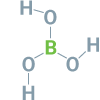



Boron
(B)
Very
Fairly
Moderately
| B | ||
|---|---|---|
| Sugar Beet | ||
| Sunflower | ||
| Winter Rapeseed | ||
| Carrot | ||
| Apple | ||
| Cabbage | ||
| Grape Vine | ||
| Lettuce | ||
| Tomato | ||
| Cherries | ||
| Pear | ||
| Silage Maize | ||
| Grain Maize | ||
| Potato | ||
| Strawberry | ||
| Fiber Flax | ||
| Cucumber | ||
| Spring Barley | ||
| Winter Barley | ||
| Winter Wheat |
Boron deficiency in plants appears as chlorosis, deformities or necrosis of parts of the crop.
Boric acid is a powerful bactericide. Even for demanding crops such as rapeseed, excess should be avoided as it can have a negative impact on yields.
Boron is concentrated naturally through quite a complex geological cycle. For this reason, boron deposits are quite scarce. The process takes place in two stages:
1) a very long precipitation in an inner pocket in which the boron escapes into fumaroles,
2) a crystallisation, with re-solubilisation and concentration in a warm, inland sea subjected to evaporation. Boron is deposited at the bottom, either as calcium or sodium borate.
The challenge for the industry, therefore, is to formulate a ready-to-use product with a proper level of solubility for nutritional efficiency.
LAT Nitrogen uses two production methods. One consists of using acid to make boron soluble and then complexing it in an organic molecule to protect it from overly rapid deterioration. The other method is micronisation to ensure that it can penetrate leaves when used for foliar fertilization.
The soil extraction method by hot water is relatively well-established. We can consider the following minimum limits:
A big part of the soluble boron comes from organic matter. A low organic matter content limits the availability of boron in the soil solution. Less than 1.8% organic matter content indicates a high risk of deficiency.
LAT Nitrogen Austria GmbH
St.-Peter-Strasse 25
4021 Linz, Austria
















